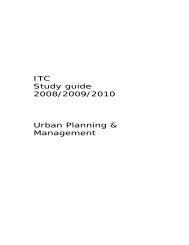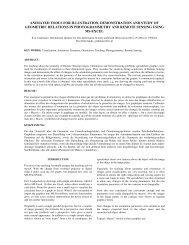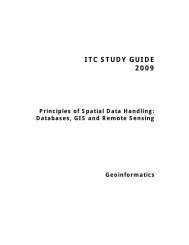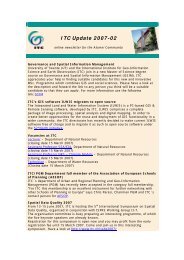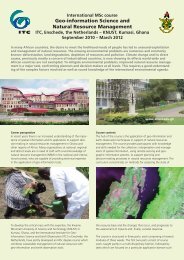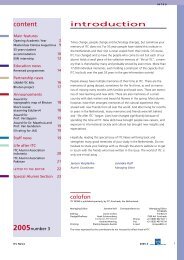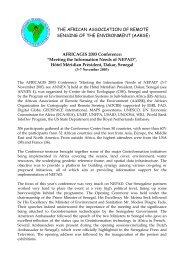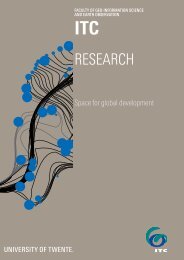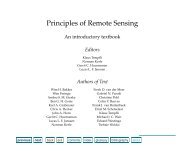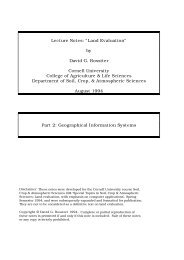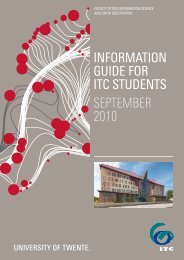Sensitivity Analysis of Soil Site Response Modelling in Seismic ... - ITC
Sensitivity Analysis of Soil Site Response Modelling in Seismic ... - ITC
Sensitivity Analysis of Soil Site Response Modelling in Seismic ... - ITC
Create successful ePaper yourself
Turn your PDF publications into a flip-book with our unique Google optimized e-Paper software.
As the population grows the risk gets higher <strong>in</strong> many earthquake prone areas, especially <strong>in</strong> develop<strong>in</strong>g<br />
countries. Over 90 % <strong>of</strong> disaster related deaths occur among the two-thirds <strong>of</strong> the world’s population<br />
who live <strong>in</strong> the less developed countries and about three quarters <strong>of</strong> all the economic damage is conf<strong>in</strong>ed<br />
to the more developed countries (Smith 2001). Thus Asia, suffers greatly from natural disasters<br />
because <strong>of</strong> its large population, many <strong>of</strong> whom live <strong>in</strong> poverty and are concentrated <strong>in</strong> dense clusters<br />
<strong>in</strong> tectonically active zones or near low-ly<strong>in</strong>g coasts subject to cyclones and floods. Additionally, most<br />
earthquakes kill<strong>in</strong>g more than 100,000 people have occurred along the Himalayas, the Middle East and<br />
the Alps to the western Mediterranean and North Africa (Smith 2001). Casualty and the occurrence<br />
rate make Nepal one <strong>of</strong> the most vulnerable areas <strong>in</strong> the world. Above all, be<strong>in</strong>g a develop<strong>in</strong>g country,<br />
it is one <strong>of</strong> the places that need special attention regard<strong>in</strong>g the disaster issues.<br />
Many develop<strong>in</strong>g countries lack <strong>in</strong> fund<strong>in</strong>g for the studies that are needed for risk analysis and further<br />
studies. Many big organizations such as European Commission (EC) and United Nations (UN) have<br />
projects ongo<strong>in</strong>g <strong>in</strong> the area. Although the special attention needed is given, there is still need for new<br />
researches and implementations.<br />
One <strong>of</strong> the current research projects at <strong>ITC</strong> also focuses on risk management, and is entitled “Strengthen<strong>in</strong>g<br />
Local Authorities <strong>in</strong> Risk Management”. In this project Kathmandu and its surround<strong>in</strong>g regions<br />
are chosen as case study areas. This research falls <strong>in</strong>to the seismic hazard assessment section and also<br />
will be an <strong>in</strong>put for further analysis such as, build<strong>in</strong>g and population vulnerability estimation.<br />
As mentioned before risk management starts with the characterization <strong>of</strong> the hazard, which is seismic<br />
hazard analysis. For seismic hazard analysis and mapp<strong>in</strong>g a popular approach is to create zones. <strong>Seismic</strong><br />
zon<strong>in</strong>g can be dist<strong>in</strong>guished <strong>in</strong>to two: macro and microzon<strong>in</strong>g. <strong>Seismic</strong> macrozon<strong>in</strong>g consists <strong>of</strong><br />
divid<strong>in</strong>g the national territory <strong>in</strong>to several areas <strong>in</strong>dicat<strong>in</strong>g progressive levels <strong>of</strong> expected seismic <strong>in</strong>tensity<br />
for different return periods. These zones can be described <strong>in</strong> terms <strong>of</strong> peak acceleration values<br />
or any other strong ground motion parameter (Giard<strong>in</strong>i 1999). Macrozon<strong>in</strong>g, different then microzon<strong>in</strong>g<br />
focuses on small scales and <strong>in</strong>cludes probability. As seen below (Figure 1-2), the scale <strong>of</strong> the maps<br />
helps just to give an overall idea <strong>of</strong> the earthquake prone regions. For def<strong>in</strong><strong>in</strong>g earthquake source<br />
zones regional tectonics are used but they do not take <strong>in</strong>to account the regional geology. Earthquake<br />
catalogues are important <strong>in</strong> this assessment s<strong>in</strong>ce they po<strong>in</strong>t out the tectonically active regions.<br />
2<br />
<strong>Sensitivity</strong> <strong>Analysis</strong> Of <strong>Soil</strong> <strong>Site</strong> <strong>Response</strong> <strong>Modell<strong>in</strong>g</strong> In <strong>Seismic</strong> Microzonation For Lalitpur, Nepal



